| City/Town: • Miami |
| Location Class: • Commercial |
| Built: • 1896 | Abandoned: • 2022 |
| Status: • Demolished |
| Photojournalist: • David Bulit |
The Story of the Morris Brothers Block
Morris Brothers was a short-lived chain of department stores that operated in Miami and Miami Beach from 1935 to 1956. Their downtown location was situated at 76 East Flagler Street, which was formerly the site of three historic buildings: the Fort Dallas Building, the Sewell Building, and the Roxy Theater. To fully understand the story of Morris Brothers, it is essential to discuss these buildings, their histories, and the pioneers who helped build the city of Miami.

Fort Dallas Building
The Fort Dallas Building was one of the oldest structures in Miami, constructed in 1896 by Standard Oil co-founder Henry M. Flagler for the Fort Dallas Land Company, which later became the Model Land Company. The name derives from the fact that the building was constructed on the former site of Fort Dallas, an old military base established in 1836 on the former plantation of Richard Fitzpatrick. The United States Navy used the base “for the purpose of harassing the enemy” by preventing trading between the Seminole Indians and traders from Cuba and the West Indies during the Seminole Wars.
Flagler in Florida
Flagler first came to Florida in 1879 on the recommendation of his physician to escape the harsh conditions of the North for his ailing wife, Mary Harkness, who suffered from tuberculosis. After his wife died in 1881, he remarried his wife’s caregiver, Ida Alice Shourds. For their honeymoon, the couple traveled to Saint Augustine, and while Flagler found the city charming, he also found the hotel facilities and transportation systems inadequate.
In 1885, he returned to Saint Augustine to pursue new interests, namely the construction of the Ponce de Leon Hotel, and purchased and modernized short line railroads that would allow for heavier loads and more traffic. This would later become known as the Florida East Coast Railway. After many years of work, the hotel opened on January 10, 1888, and was an instant success.
The project ignited Henry Flagler’s vision of developing a new “American Riviera.” Within two years, he expanded his ventures in Florida by constructing a railroad bridge over the St. Johns River, enabling access to the southern portion of the state. He acquired the Hotel Ormond, located just north of Daytona, and extended his railroad southward. In Palm Beach, he built the massive 1,100-room Royal Poinciana Hotel along the shores of Lake Worth and extended the railway to a newly established service town, West Palm Beach, by 1894. Flagler is credited with founding both Palm Beach and West Palm Beach. At the time, the Royal Poinciana Hotel was the largest wooden structure in the world.
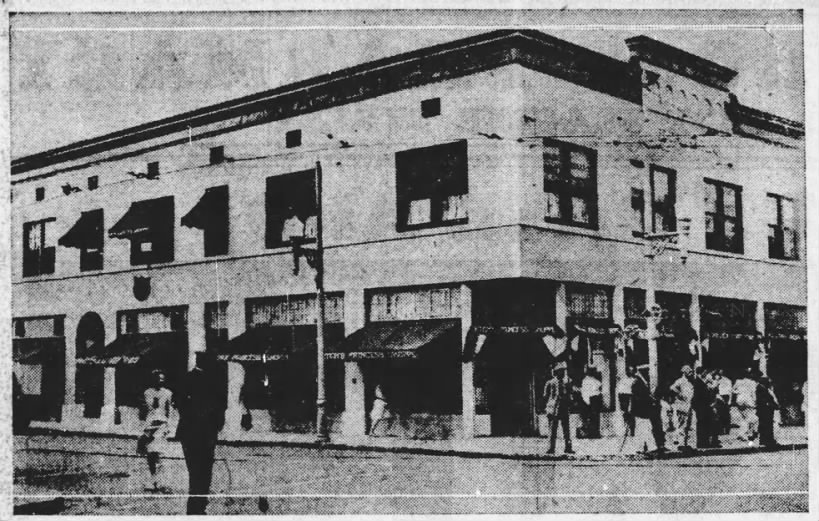
The Development of the City of Miami
Julia Tuttle owned hundreds of acres of land in the area known today as Miami and saw the potential in developing the area. Flagler originally intended West Palm Beach to be the terminus of his railroad system, but in 1894 and 1895, severe freezes hit the area, destroying much of the state’s citrus crops, causing Flagler to reconsider. Unaffected by the freeze, Tuttle and William Brickell, who ran a trading post on the Miami River, convinced Flagler to continue the railroad to Miami by offering him land in exchange for laying rail tracks.
Flagler hired John Sewell from West Palm Beach to begin work on the town as more people came into Miami, and by 1896, the Florida East Coast Railway reached Biscayne Bay. Flagler dredged a channel, built streets, instituted the first water and power systems, and financed the city’s first newspaper, The Metropolis. He also encouraged fruit farming and settlement along his railway line and made many gifts to build hospitals, churches, and schools in Florida. In 1897, Flagler opened the exclusive Royal Palm Hotel on the north bank of the Miami River, where it overlooked Biscayne Bay. The city’s first post office was located in the Fort Dallas Building.
John B. Reilly, Miami’s First Mayor
John B. Reilly headed Flagler’s Fort Dallas Land Company and was elected Miami’s first mayor. Born in Connecticut on May 18, 1870, he began his career in 1886 as a shipping clerk in Branford, Connecticut. In 1893, he relocated to Florida to work as a bookkeeper and cashier for the contracting firm McGuire & McDonald, which was responsible for building hotels for Henry M. Flagler.
By 1896, Reilly had been appointed manager of the Florida East Coast Railway and served as the company’s spokesman in Miami. That same year, following the city’s incorporation, Reilly was elected Miami’s first mayor, a position he held for four consecutive one-year terms, largely due to his influential role in the railway’s expansion. Reilly later came to own the Fort Dallas Building.
Burdine & Quarterman
John Burdine was the son of William Burdine Sr., founder of the Burdines department store chain, and worked with his father at what was then known as Burdine & Son, in a small space on the corner of South Miami Avenue and Flagler Street where the former Burdines flagship store now stands.
Eva Quarterman was a designer and seamstress at Burdine & Son, but left the firm in 1903 along with John Burdine to go into business for themselves. With a capital of $3,700, the firm Burdine & Quarterman opened in the Fort Dallas Building that same year. Weeks later, an ad was purchased in The Miami Metropolis, “inviting every Quarterman and Burdine customer to avail herself of the shopping and merchandising facilities of Burdine’s, from now on.”
In 1923, the firm was sold to Melville O. Fullam and Annie Jennings Horne, both of whom were employees at the store, as well as Allister G. Harkness. Within two years, it was decided that it was time to expand, and a growing belief emerged that the future of business in Miami was shifting north of downtown. So, a location was chosen at the corner of Northeast 9th Street and Northeast 2nd Avenue due to its accessibility by streetcar and city bus, and with ample parking space, which Flagler Street lacked.
The result was an imposing, five-story Venetian-Gothic style department store designed by the architectural firm Kiehnel and Elliott, and built by the contractor John Barclay Orr in 1926. Made of reinforced concrete, each floor offered 9,000 square feet of floor space with additional space on the first-floor mezzanine, and was designed in such a manner that three additional stories could be added without detracting from the building’s architectural design. Decades later, Harkness recalled that the building was erected “just as the bubble burst,” adding, “We dropped half a million on that deal.”
Within ten months, Burdine & Quarterman went bankrupt, and the new store went into receivership. In its final advertisement, the management of the firm admitted, “Now you can save thousands of dollars thru the mistake we made by moving from the down-town district. This move cost of thousands and thousands of dollars, because we are forced to sacrifice our entire stock, regardless of price, to close out at our present location.“
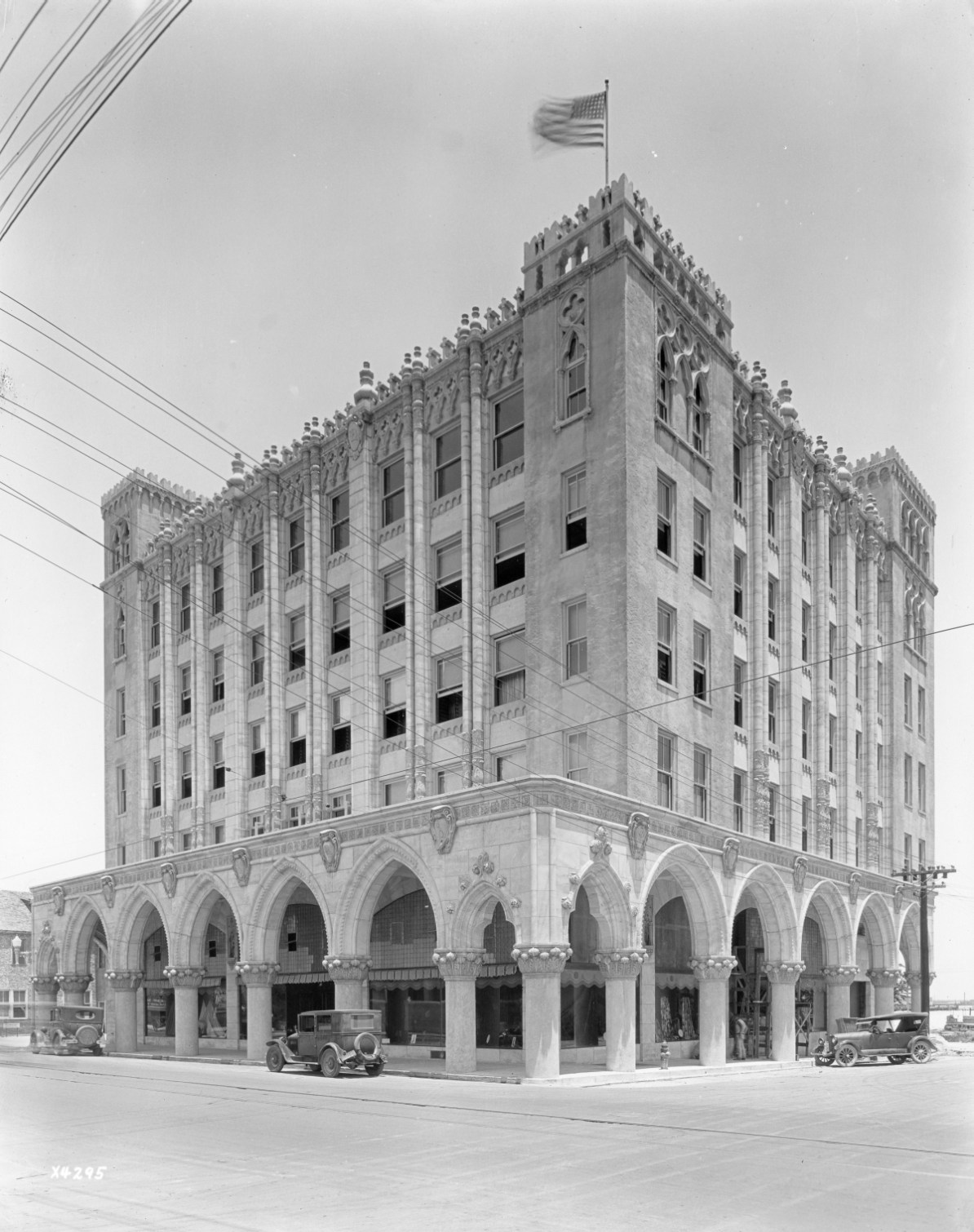

Hollywood Land & Water Company
When Burdine & Quarterman was purchased in 1923, the firm had taken a five-year sublease on the Fort Dallas Building. After moving out two years later, the last three years of its lease were sold to the Hollywood Land & Water Company, owned by the founder of Hollywood, Florida, Joseph Young.
Joseph Young first arrived in South Florida in January 1920 to survey several parcels of land that would be suitable for the site of his “Dream City in Florida.” With the formation of the Hollywood Land & Water Company, composed of twenty-six departments covering every aspect of city-building, Joseph Young began earnestly bringing to reality his vision of Hollywood. In February 1921, Young purchased at approximately $175 per acre the first parcel of land that would evolve into present-day Hollywood. Young was successful in attracting numerous potential residents to visit and eventually purchase property in what was then known as Hollywood-by-the-Sea.
Before the Hollywood Land & Water Company moved its offices into the Fort Dallas Building in 1925, the company occupied a space on the ground floor of the Columbia Building located across the street to the east of the Fort Dallas Building.
Fort Dallas Building Renovation
After the Hollywood Land & Water Company lease expired on May 1, 1928, the building’s management was transferred to the Trust Company of Florida. Under its supervision, plans were drawn by architect C.H. Oemler for the entire remodeling of the building into a shopping center featuring seven stores located on the ground floor. A restaurant, a beauty salon, and a dentist’s office occupied the second floor.
Liggett’s Drug Store occupied part of the ground floor until 1945, when its lease expired. The Liggett Drug Company was founded by Louis Kroh Liggett, president of the United Drug Company and founder of Rexall Drugs. Jay-Barth Millinery Shop, established in 1930 in the Langford Building, moved into a space on the ground floor of the Fort Dallas Building in 1933.
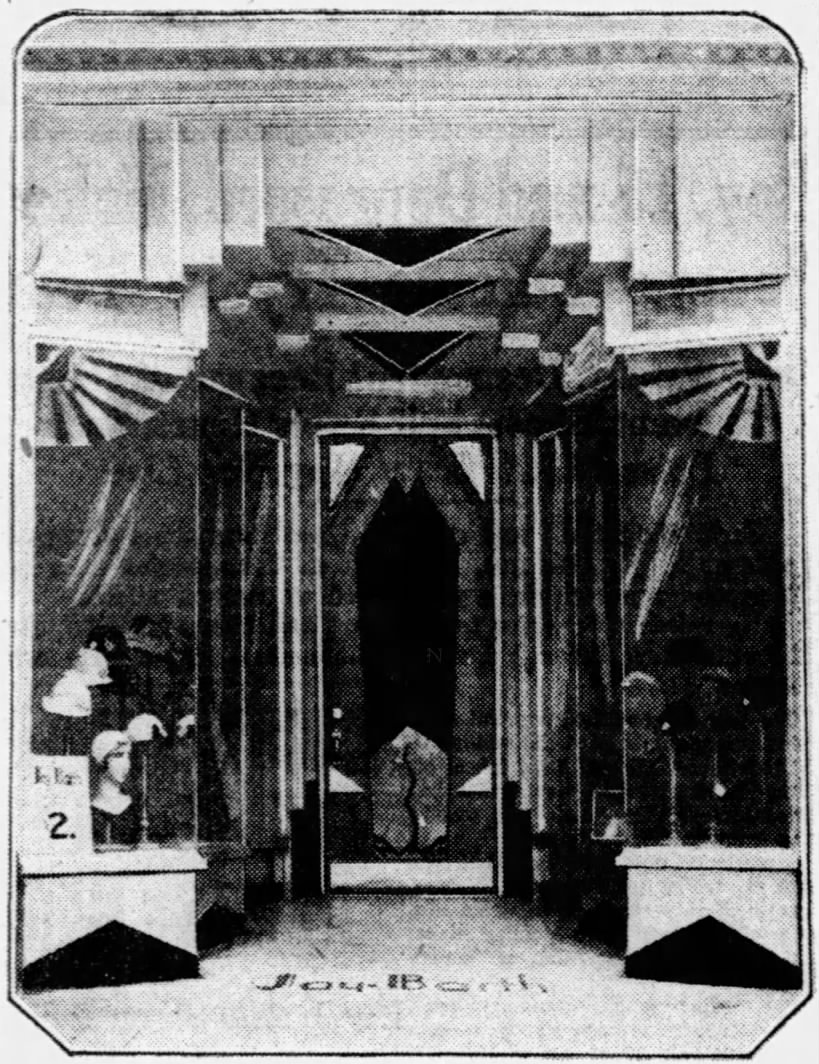
Sewell Building
The Sewell Brothers, “Big John” and “Ev”
John Washington Sewell was born in Elbert County, Georgia, on July 20, 1867, the son of Dr. Jeremiah Washington Sewell, a well-known physician. In 1886, the family relocated to Florida, settling in Kissimmee. As a young man, Sewell became involved in several business ventures, including a sawmill and an ice business.
He later moved to the East Coast of Florida with J. S. Oliver, who held a contract to build the Florida East Coast Railroad. Around 1891, Sewell left Oliver’s employ and accepted a more senior role with the railroad, supervising the construction of track between Daytona and Rockledge. Once that section was completed, he was sent to Jupiter, where he oversaw the transfer of construction materials for the Royal Poinciana Hotel. He was then transferred again to Palm Beach, where he took charge of grading the expansive grounds on the Poinciana property.
When railroad work began in Miami, Sewell was transferred once more, this time to oversee excavation efforts in the city. Everest George Sewell, the younger brother of John W. Sewell, was born September 17, 1874, and worked in a general store in Kissimmee until 1896, when he decided to move to Miami with his brother. The two arrived aboard the S.S. Rockledge on March 3, 1896, along with a dozen or so laborers to prepare the site for the Royal Palm Hotel.
John Sewell oversaw the excavation of an Indian burial mound and the removal of about 50 to 60 skeletons where the Royal Palm Hotel would be built. Upon completion of that work, he was placed in charge of grading the streets, cutting rights-of-way, and establishing sidewalks. He once said, “Julia Tuttle gave the land, and Henry Flagler the money, but I started Miami.”
While the workmen lived in tents, the Sewell brothers resided on the old steam ship until the Miami Hotel was built. This hotel was constructed by Julia Tuttle on South Miami Avenue, along the north bank of the Miami River. However, she sold the building before its completion due to her lack of experience as a hotelier. It is said that the brothers moved in before any windows or staircases were installed, using ladders to access the upper floors.

Establishment of the Sewell Brothers Store
On John’s behalf, a space on the hotel’s ground floor was set aside for a store. Within a month of their arrival, the brothers received a stock of goods and, with a capital of $1,500, opened a shoe store on March 25, 1896. Before its opening, the Brickells operated a trading post on the south side of the Miami River; there was no store or trading post on the north side. Because of this, the Sewell brothers’ store is considered the city of Miami’s first store.
One notable feature of the store was its safe, the only one in town, which was used to store the business’s funds securely and the money necessary to pay the workers involved in the construction of the Royal Palm Hotel. John B. Reilly, who led Henry Flagler’s Fort Dallas Land Company, was responsible for disbursing the construction funds and had his office located in the Sewell store. Additionally, Dr. James M. Jackson, the city’s first resident physician and founder of Jackson Memorial Hospital, also had his office in the Sewell store.


After eight months, on December 15, 1896, the Sewell brothers moved into the more spacious Biscayne Hotel, a red brick building located at the corner of 12th Street (Flagler Street) and Avenue D (Miami Avenue). This relocation occurred just before a fire ravaged the area, destroying twenty-eight buildings. The Metropolis described the destroyed structures as made of wood, and nearly all were cheaply constructed. They remained at this location until 1898, when they purchased the lot, and the first iteration of the Sewell Building was built—a small two-room store. In the following years, this building would undergo extensive expansions and renovations.
In June 1898, the town experienced its first economic boom during the Spanish-American War when 7,000 volunteer soldiers arrived in Miami to train at Camp Miami, a newly established facility intended for deployment to Cuba. It was during this time that the store’s inventory was expanded to include men’s apparel, selling black satin shirts, uniforms, and campaign hats to the civilian soldiers.
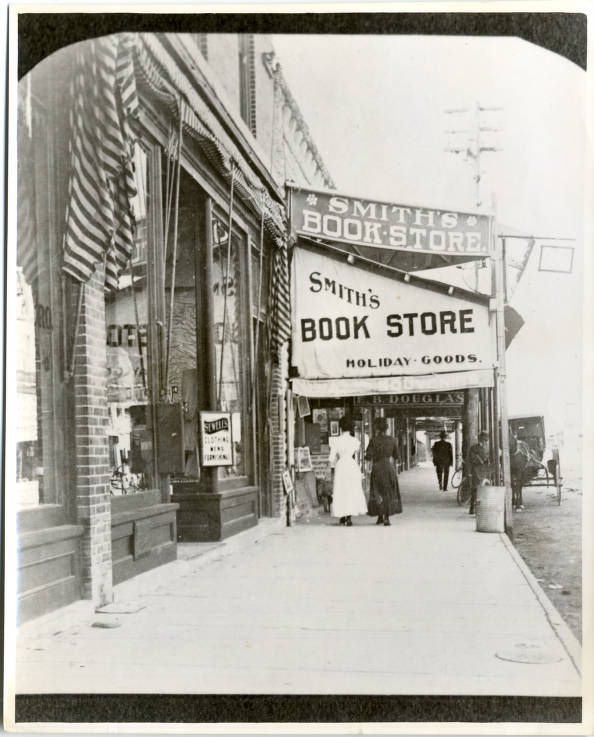
The Flagler Street Location
Around the turn of the century, the firm began operating under the name John Sewell & Bro., as John had transitioned from the construction business to focus on mercantile full-time. The name eventually changed to Sewell Bros. Two branches were opened in Palm Beach, including one in the Royal Poinciana Hotel, and the Miami store was doubled in size. In 1906, the two branches were sold to focus their resources on the Miami store, which was then expanded.
On July 15, 1916, construction began on a $30,000 renovation of the Sewell Bros. store. The store remained operational during construction as it was reported that “the building was literally built around it,” until its completion on December 1, 1916. The building would from then on be known as the Sewell Building.
Constructed of reinforced concrete, the building featured a white exterior made of terra cotta with large French plate glass window displays framed with copper tubing described as a model “Kawneer” storefront. The entire interior was finished in colonial white, except for the clothing department, which featured French gray oak, with mosaic flooring throughout the building. The building was also split into two separate stores—one side was for men’s shoes, and the other side was for men’s clothing and accessories such as hats, canes, and umbrellas. The second floor contained the boys’ department, sweaters, bathing suits, trunks, and bags.

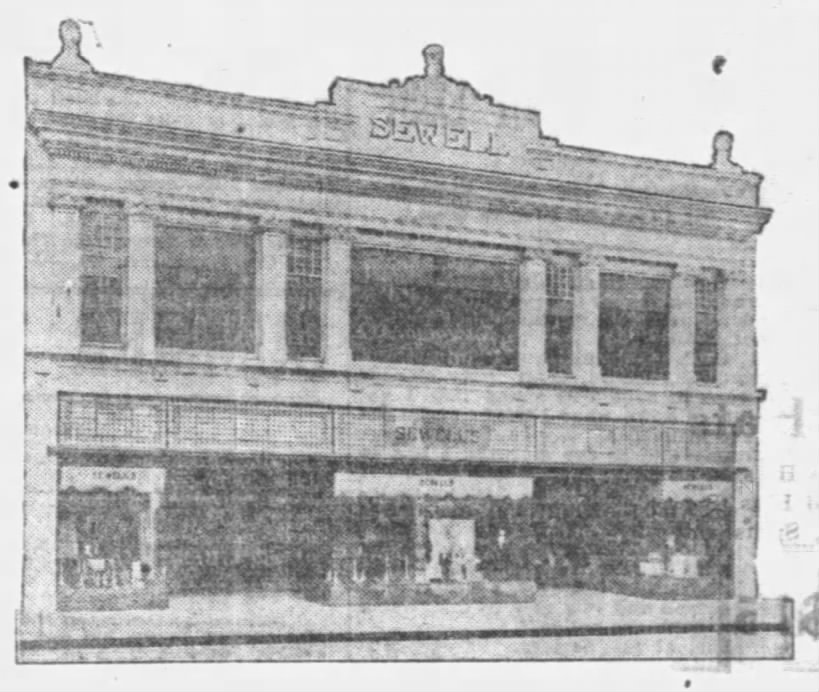
In August 1932, it was announced that Sewell Brothers would be closing due to the business’s failure to recover from heavy losses incurred in the disastrous 1926 hurricane and the depression that followed. By then, the brothers Everest had headed the Chamber of Commerce from 1915 to 1925 and served as mayor from 1927 to 1929. He was also involved in the real estate business, with offices located in the Biscayne Hotel, until he moved to the second floor of the Sewell Building.
In 1932, the Sewell Building underwent an extensive renovation and was rebranded “The Sewell Building Quality Shops,” and included a men’s shoe store and a women’s fashion store that occupied the ground floor, and a beauty salon on the second floor.
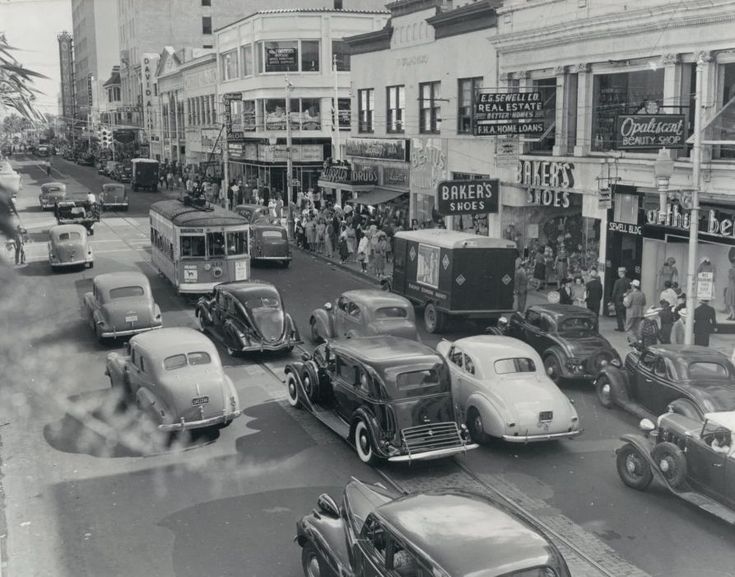
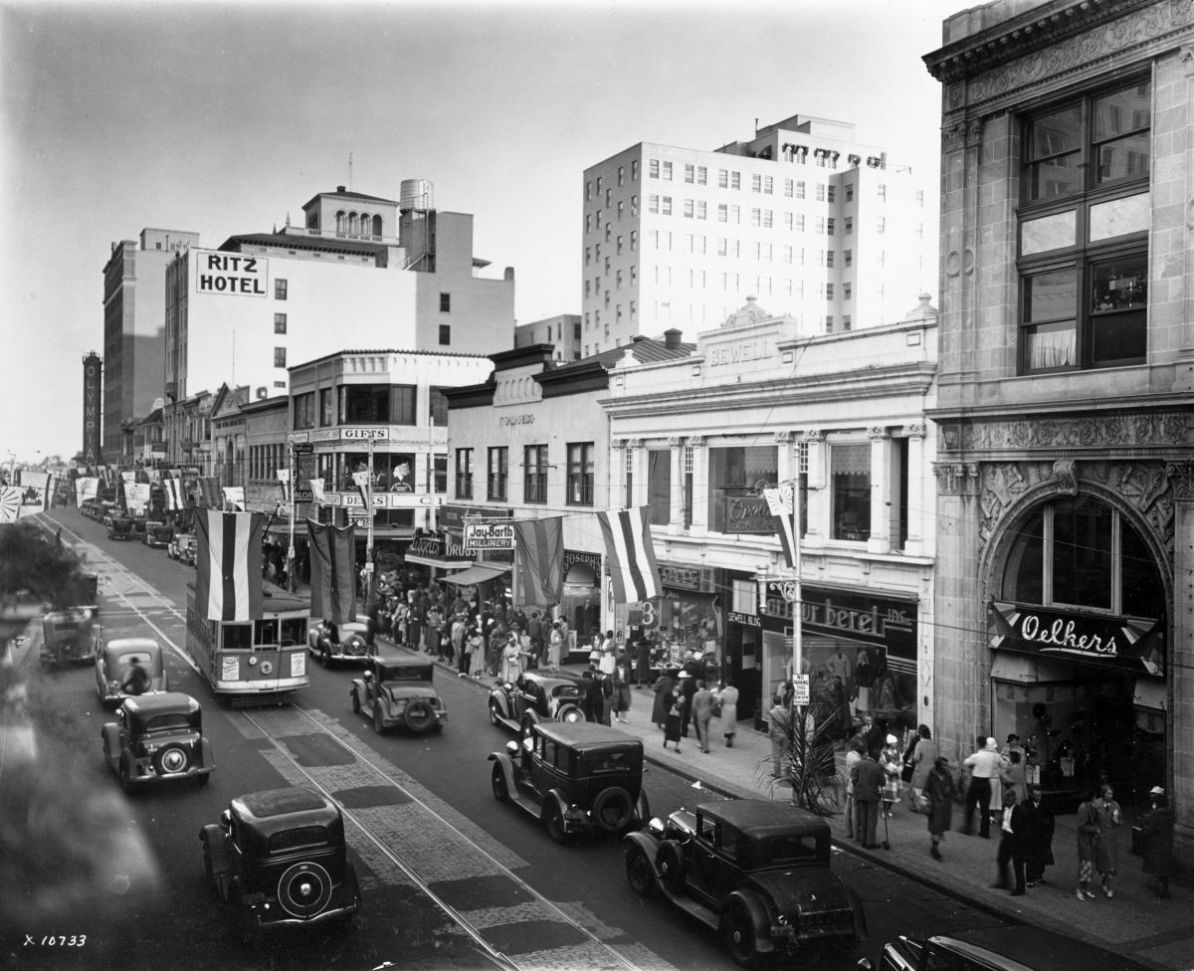
The Roxy Theater
The Roxy Theater was built in 1916 on the corner of Thirteenth Street (Southeast 1st Street) and Avenue C (Southeast 1st Avenue) in downtown Miami. It opened as the Paramount Theater and was owned by the Paramount Amusement Company, founded by J. C. Boss, William A. Leach, and Harry A. Leach. At the time, Boss owned several other theaters in the area, including the Arcade, Airdome, and Fotosho Theaters. J. C. Boss would eventually sell all his interests to the Leach brothers, who in turn would then partner with Famous Players-Lasky to form the Miami branch of Paramount-Publix.
The second floor of the building housed the Paramount Hotel, which was eventually enlarged to include a third floor and several shops on the ground floor.
In 1931, the New Fairfax Theatre, located at 257 East Flagler Street, underwent significant renovations and was enlarged, subsequently being renamed the Paramount Theatre. The old Paramount Theatre reopened as the Roxy Theater on January 7, 1932, featuring Clark Gable in “Sporting Blood.” The Roxy Theater had another reopening in December 1932 with Helen Foster starring in “The Primrose Path.” Both theaters were operated by Paramount Pictures Inc. through its subsidiary, S.A. Lynch.
On May 13, 1943, the Roxy Theater burned to the ground after a fire started in the dressing room of the theater under the stage, reportedly from a “carelessly tossed” cigarette or a match. The fire quickly spread through the ventilation shaft, engulfing the wooden structure. No one was injured in the fire. The building was later demolished.


Big Changes on Flagler Street
By 1938, several property transactions had taken place that altered the blueprint of downtown Miami, making it difficult to explain. S. H. Kress & Company had acquired the Venetian Arcade from E. B. Douglas, located just west of the Sewell Building, for their new downtown location. Their old location at 24 East Flagler Street, just east of Burdine’s, was purchased by Lerner Shops. Lerner’s was originally located at 38 East Flagler Street, but moved as Woolworth’s wanted to expand its location at 46 East Flagler Street. The old Biscayne Hotel had also been purchased by Burdine’s for the construction of their new store.
On the other side of the block, Alexander’s Department Stores acquired the lease on the Fort Dallas Building in May 1938 from John Burdine, who at the time still owned a 99-year lease on the property, for $100,000. That same year, it was reported that the Dundee Corporation had purchased the Sewell Building for $360,000. The Dundee Corporation was part-owned by Samuel A. Lerner, co-founder of Lerner Shops.
Alexander’s had expressed interest in purchasing the lease of the Roxy Theater for the possibility of constructing a new department store, but it was later reported that the Dundee Corporation had acquired the lease before them. It’s not known what the reasoning was, but Alexander’s then resold the lease it had on the Fort Dallas Building to the Dundee Corporation for $135,000. This final transaction brought all three properties—the Fort Dallas Building, the Sewell Building, and the Roxy Theater—under the holding of the Dundee Corporation.
While it was speculated that a larger Lerner’s was to be constructed on the site, the properties and leases were sold to an unknown buyer and subsequently resold to Morris Brothers, a small chain of local department stores, in 1943.
The Morris Brothers Block
Morris Brothers was established in 1935 by Dr. Morris Goodman and his brothers, Abe and Jack Goodman. Dr. Morris Goodman was born in Russia in 1899 and obtained his medical degree from New York University. He worked as a cardiologist at Bellevue Hospital in New York and served as an assistant professor at the Medical College of New York University. In 1937, he relocated to Miami to concentrate on the family retail business. Their first location was at 1261 Washington Avenue on Miami Beach, one of the prominent stores in the area alongside McCrory’s, S. H. Kress, and Nelson’s.
The proposed building on Flager Street was five stories high, with the option of adding three additional floors, and 120,000 square feet of sales space. The estimated $1 million new construction would have seen the complete demolition of the Fort Dallas Building and the Sewell Building.
It was noted that plastic was to be used extensively in the construction of the showcases and other fixtures as plastic production and usage surged due to its crucial role in World War II and its subsequent adoption for civilian applications. “The beautiful colors available in plastics can be used most effectively to harmonize with merchandise due to the medium’s flexibility for interchangeable backgrounds and display units,” Dr. Goodman said. “A range of modern pastels, including gray, green, soft coral, rose, and purple, will be used throughout the store in rugs, walls, draperies, and upholstery.“

Unlike the owners of Burdine & Quarterman, who decades prior believed the city’s business district was moving away from downtown, Dr. Morris Goodman chose the site because he believed it would continue to be the busiest area in the city. He envisioned a post-war Miami as a cosmopolitan trade center with the latest advancements in fashion and other industries.
In the meantime, a small store was opened in the present building in November 1943, limited in scope due to wartime regulations, and specialized in jewelry, handbags, dresses, and sportswear. One advertisement read, “Our plans for a Million Dollar Department Store in Miami will be carried out upon lifting of wartime regulations. Until we can build, we give you a limited edition of that ‘store of the future.‘”

It’s not known what occurred, but the initial plans were abandoned, and the final result was a two-story structure that involved an extensive renovation of the Fort Dallas Building and Sewell Building. The only new construction was on the former site of the Roxy Theater.
In November 1948, it was reported that streetcar tracks, “rails, crossties, and everything,” were uncovered while excavating underneath the Sewell Building during the renovation of the building.
Within a few years, the first sign that Morris Brothers was failing was in October 1954, when it was announced that their Miami Beach location was being sold to Leonard Barr and Sam Liption, operators of Jackson Stores. Dr. Goodman, though, emphasized that this sale would not affect the Flagler Street location. Within two years, Morris Brothers was out of business.

Natan Rok, Humble Beginnings at Morris Brothers
The former Morris Brothers department store in downtown Miami was subdivided into smaller retail spaces and leased out. One of these businesses was Dandy Men’s Wear in 1965, owned by Natan Roberto Rok, who had fled Cuba the year prior. This business eventually expanded to six stores.
Maybe inspired by the approach Morris Brothers took with their building, Rok purchased an old Walgreens on the northwest corner of East Flagler Street and Miami Avenue, and split it into five stores. Having found success with this concept, he went on to do the same with the building across the street, purchasing a 20-year lease and dividing that one into ten stores. Soon, he was making $20,000 a month profit from that building alone. He continued the process: buying a big building, cutting it up and renting it out, until eventually he was the landlord of over 300 merchants downtown.
Out With the Old, In With the New
In 2015, developer Moisha Mana purchased the former Morris Brothers block and neighboring Flagler Station for $35 million. Flagler Station was formerly the S. H. Kress building and was heavily renovated in the 1980s into a shopping mall. The Morris Brothers block, by this time, was occupied by several businesses.
This purchase would be part of Mana’s second major development in Miami, known as the MANA Common. The development will include more than 5,000 micro-units designed for residents to live, work, and play, along with shared collaborative workspaces. Driven by his belief that investing in people’s creativity and ambition is more meaningful than simply collecting rent, Mana has backed a wide range of startups across various industries. The project also aims to address Miami’s housing crisis by introducing much-needed middle-income housing to the urban core.
In 2019, the building received a violation for being an unsafe structure and was recommended for demolition. A second violation for the same reason was issued in April 2022. Mana had originally planned to renovate the former Flagler Station and Morris Brothers buildings. However, due to the extent of damage and deterioration, the decision was made to demolish them. Although the Fort Dallas Building was technically the same building as it was when built in 1896, as was the Sewell, extensive renovations over the past 120 years resulted in the loss of its historic value. In July 2025, one of the oldest corners of Miami was demolished to make way for a new future for the area.






























thank you for this!!!!!!!